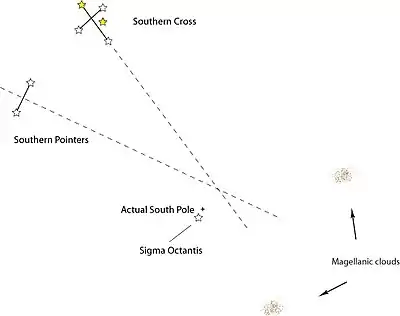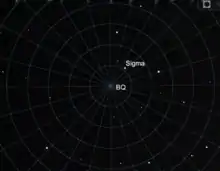Polar alignment
Polar alignment is the act of aligning the rotational axis of a telescope's equatorial mount or a sundial's gnomon with a celestial pole to parallel Earth's axis.
Alignment methods
The method to use differs depending on whether the alignment is taking place in daylight or in night. Furthermore, the method differs if the alignment is done in the Northern Hemisphere or Southern Hemisphere. The purpose of the alignment also must be considered; for example, the value of accuracy is much more significant in astrophotography than in casual stargazing.
Aiming at the pole stars
In the Northern hemisphere, sighting Polaris the North Star is the usual procedure for aligning a telescope mount's polar axis parallel to the Earth's axis.[1] Polaris is approximately three quarters of a degree from the North Celestial Pole, and is easily seen by the naked eye.
σ Octantis, sometimes known as the South Star, can be sighted in the Southern hemisphere to perform polar alignment. At magnitude +5.6, it is difficult for inexperienced observers to locate in the sky. Its declination of -88° 57′ 23″ places it 1° 2′ 37" from the South Celestial Pole. An even closer star BQ Octantis of magnitude +6.9 lies 10' from the South Pole as of 2016. Although not visible to the naked eye, it is easily visible in most polar 'scopes. (It will lie its closest to the South Pole, namely 9', in the year 2027.


Rough alignment method
In the Northern hemisphere, rough alignment can be done by visually aligning the axis of the telescope mount with Polaris. In the Southern hemisphere or places where Polaris is not visible, a rough alignment can be performed by ensuring the mount is level, adjusting the latitude adjustment pointer to match the observer's latitude, and aligning the axis of the mount with true south or north by means of a magnetic compass. (This requires taking the local magnetic declination into account). This method can sometimes be adequate for general observing through the eyepiece or for very wide angle astro-imaging with a tripod-mounted camera; it is often used, with an equatorially-mounted telescope, as a starting point in amateur astronomy.
There are ways to improve the accuracy of this method. For example, instead of reading the latitude scale directly, a calibrated precision inclinometer can be used to measure the altitude of the polar axis of the mount. If the setting circles of the mount are then used to find a bright object of known coordinates, the object should mismatch only as to azimuth, so that centring the object by adjusting the azimuth of the mount should complete the polar alignment process. Typically, this provides enough accuracy to allow tracked (i.e. motorized) telephoto images of the sky.
For astro-imaging through a lens or telescope of significant magnification, a more accurate alignment method is necessary to refine the rough alignment, using one of the three following approaches.
Polarscope method
An alignment suitable for visual observation and short exposure imaging (up to a few minutes) can be achieved with a polarscope. This is a low magnification telescope mounted co-axially with the mount (and adjusted to maximise the accuracy of this alignment). A special reticle is used to align the mount with Polaris (or in the southern hemisphere a group of stars near the polar region). While primitive polarscopes originally needed the careful adjustment of the mount to match the time of year and day, this process can be simplified using computer apps which calculate the correct position of the reticle. A new-style northern-hemisphere reticle uses a 'clock-face' style with 72 divisions (representing 20 minute intervals) and circles to compensate for the drift of polaris over around thirty years. Use of this reticle can allow alignment to within an arc minute or two.[2]
Drift alignment method
Drift alignment is a method to refine the polar alignment after a rough alignment is done. The method is based on attempting to track stars in the sky using the clock drive; any error in the polar alignment will show up as the drift of the stars in the eyepiece/sensor. Adjustments are then made to reduce the drift, and the process is repeated until the tracking is satisfactory. For the polar axis altitude adjustment, one can attempt to track a star low in the east or west. For the azimuth adjustment, one typically attempts to track a star close to the meridian, with declination about 20° from the equator, in the hemisphere opposite of the observing location.
Plate solving
For telescopes combined with an imaging camera connected to a computer it is possible to achieve very accurate polar alignment (within 0.1 minute of arc) by approximately aligning it, then identifying the exact field of view when aimed at stars near the pole - 'plate solving'. The telescope is then rotated ninety degrees around its right ascension axis and a new 'plate solve' carried out. The error in the point around which the images rotate compared to the true pole is calculated automatically and the operator can be given simple instructions to adjust the mount for close polar alignment.[3]
Equipment
Crosshair eyepiece
A crosshair eyepiece is an ordinary ocular with the only difference that it has a crosshair for aiming and measurement of the angular distance. This is useful in any type of polar alignment, but especially in drift.
Dedicated polar scope
A small telescope usually with an etched reticle that is inserted into the rotational axis of the mount.
References
- Michael A. Covington (1999). Astrophotography for the amateur. ISBN 978-0-521-62740-5.
- "New Style Reticle for PolarFinder". www.stubmandrel.co.uk.
- "Polar Alignment – SharpCap – Lunar, Planetary, Solar and Deep Sky Imaging. EAA and Live Stacking".